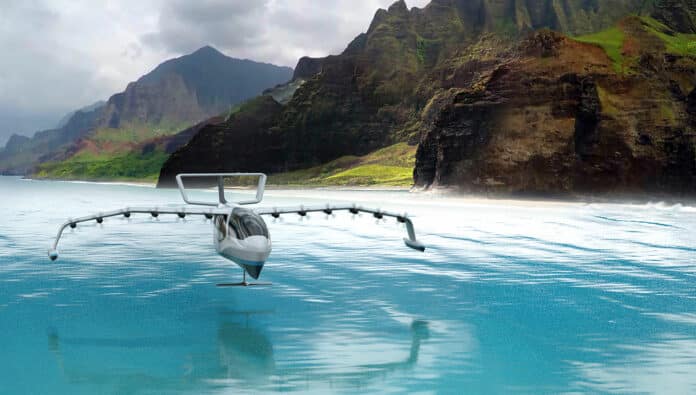The Hawaiʻi Seaglider Initiative (HSI) aims to provide an affordable and accessible transportation option to communities in Hawaiʻi by using all-electric, zero-emission vessels called Seagliders.
Regent’s “Viceroy Seaglider” is designed with a retractable hydrofoil system that reduces drag and uses an Ekranoplan-style wing-in-ground effect and blown wing to increase aerial range.
This design promises to carry up to 12 passengers and two crew members or 3,500 lbs (1,600 kg) of cargo over at least 180 miles (300 km) at a cruise speed of 180 mph (300 km/h), reducing the time and cost of transporting people and freight between coastal communities. Seagliders operate by floating on a hull before transitioning to wave-tolerant underwater hydrofoils and can take flight at ultra-low altitudes, 30 to 60 feet above the water’s surface.
It’s faster and more comfortable than a boat and can operate in much higher wave conditions while being much quieter and half the operating costs of an aircraft. It may take longer to charge, but it also has zero emissions.
Seagliders can provide a more affordable transportation option for rural communities in Hawaii. Because they operate over water, seagliders can connect these communities to medical care, jobs, and other important services at a lower cost.
In addition, seagliders can be used to transport cargo, including food and other essential goods, between islands. This will help bring down transportation and supply chain costs, ultimately reducing the price of goods and increasing the purchasing power of Hawaii’s residents. A route feasibility study estimates that a one-way seaglider ticket from Oʻahu to Maui or Oʻahu to Kauaʻi could cost $30, making it a more affordable option for everyone.
Seagliders can also be outfitted to transport cargo between islands, including food and other essential goods. Bringing down transportation and supply chain costs will help bring down the price of goods, increasing the purchasing power of Hawaiʻi residents.
HSI has also signed a memorandum of understanding with the Hawai’i Department of Transportation (HDOT). HDOT is supportive of exploring alternative forms of interisland transportation that use renewable energy for passenger and freight services. This initiative plans to collaborate with HDOT and work with other state and local government agencies to support the state’s 2045 decarbonization goals.
“The Hawai’i Department of Transportation is proud to collaborate with the Hawai’i Seaglider Initiative as part of the state’s long-term efforts to build resilience into our transportation systems,” said Hawai’i Department of Transportation Director Ed Sniffen. “Seaglider technology has strong potential to provide an efficient, affordable, and renewable alternative form of interisland transportation for both passengers and freight. This memorandum of understanding will provide the framework for government, private, and community stakeholders to work together in a thoughtful and coordinated approach to address the many environmental, cultural, economic, and technical components associated with integrating seaglider technology into our transportation network and infrastructure.”
